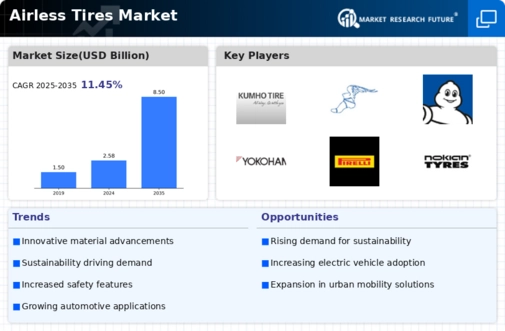-
\r\n6. AIRLESS TIRES MARKET, BY APPLICATION (USD BILLION)
-
\r\n6.1. Passenger Vehicles \r\n6.2.
-
Commercial Vehicles \r\n6.3. Two-Wheelers
-
\r\n6.4. Off-Road Vehicles \r\n7.
-
AIRLESS TIRES MARKET, BY MATERIAL TYPE (USD BILLION) \r\n7.1.
-
Polyurethane \r\n7.2. Rubber \r\n7.3.
-
Plastic \r\n7.4. Composite Materials
-
\r\n8. AIRLESS TIRES MARKET, BY END USE (USD BILLION)
-
\r\n8.1. Personal Use \r\n8.2. Fleet
-
Management \r\n8.3. Industrial Use
-
\r\n9. AIRLESS TIRES MARKET, BY TIRE STRUCTURE (USD BILLION)
-
\r\n9.1. Solid Tires \r\n9.2. Foam-Filled
-
Tires \r\n9.3. Modular Tires \r\n10.
-
AIRLESS TIRES MARKET, BY REGIONAL (USD BILLION) \r\n10.1.
-
North America \r\n10.1.1. US \r\n10.1.2.
-
Canada \r\n10.2. Europe
-
\r\n10.2.1. Germany \r\n10.2.2.
-
UK \r\n10.2.3. France
-
\r\n10.2.4. Russia \r\n10.2.5.
-
Italy \r\n10.2.6. Spain
-
\r\n10.2.7. Rest of Europe
-
\r\n10.3. APAC \r\n10.3.1. China
-
\r\n10.3.2. India
-
\r\n10.3.3. Japan \r\n10.3.4.
-
South Korea \r\n10.3.5. Malaysia
-
\r\n10.3.6. Thailand
-
\r\n10.3.7. Indonesia \r\n10.3.8.
-
Rest of APAC \r\n10.4. South
-
America \r\n10.4.1. Brazil \r\n10.4.2.
-
Mexico \r\n10.4.3. Argentina
-
\r\n10.4.4. Rest of South America
-
\r\n10.5. MEA \r\n10.5.1.
-
GCC Countries \r\n10.5.2. South Africa
-
\r\n10.5.3. Rest of MEA
-
\r\n \r\n \r\n
-
\r\n11. COMPETITIVE LANDSCAPE \r\n11.1.
-
Overview \r\n11.2. Competitive Analysis
-
\r\n11.3. Market share Analysis \r\n11.4.
-
Major Growth Strategy in the Airless Tires Market \r\n11.5.
-
Competitive Benchmarking \r\n11.6. Leading Players
-
in Terms of Number of Developments in the Airless Tires Market \r\n11.7.
-
Key developments and growth strategies \r\n11.7.1. New Product
-
Launch/Service Deployment \r\n11.7.2.
-
Merger & Acquisitions \r\n11.7.3.
-
Joint Ventures \r\n11.8. Major
-
Players Financial Matrix \r\n11.8.1. Sales and Operating
-
Income \r\n11.8.2. Major Players R&D
-
Expenditure. 2023 \r\n12.
-
COMPANY PROFILES \r\n12.1. Kumho Tire \r\n12.1.1.
-
Financial Overview \r\n12.1.2. Products
-
Offered \r\n12.1.3. Key Developments
-
\r\n12.1.4. SWOT Analysis
-
\r\n12.1.5. Key Strategies
-
\r\n12.2. Continental \r\n12.2.1. Financial
-
Overview \r\n12.2.2. Products Offered
-
\r\n12.2.3. Key Developments
-
\r\n12.2.4. SWOT Analysis
-
\r\n12.2.5. Key Strategies \r\n12.3.
-
Goodyear \r\n12.3.1. Financial Overview
-
\r\n12.3.2. Products Offered
-
\r\n12.3.3. Key Developments \r\n12.3.4.
-
SWOT Analysis \r\n12.3.5. Key Strategies
-
\r\n12.4. Maxxis International
-
\r\n12.4.1. Financial Overview \r\n12.4.2.
-
Products Offered \r\n12.4.3. Key Developments
-
\r\n12.4.4. SWOT Analysis
-
\r\n12.4.5. Key Strategies
-
\r\n12.5. Hankook \r\n12.5.1. Financial
-
Overview \r\n12.5.2. Products Offered
-
\r\n12.5.3. Key Developments
-
\r\n12.5.4. SWOT Analysis
-
\r\n12.5.5. Key Strategies \r\n12.6.
-
Michelin \r\n12.6.1. Financial Overview
-
\r\n12.6.2. Products Offered
-
\r\n12.6.3. Key Developments \r\n12.6.4.
-
SWOT Analysis \r\n12.6.5. Key Strategies
-
\r\n12.7. Bridgestone \r\n12.7.1.
-
Financial Overview \r\n12.7.2. Products
-
Offered \r\n12.7.3. Key Developments
-
\r\n12.7.4. SWOT Analysis
-
\r\n12.7.5. Key Strategies
-
\r\n12.8. Sumitomo Rubber Industries \r\n12.8.1.
-
Financial Overview \r\n12.8.2. Products
-
Offered \r\n12.8.3. Key Developments
-
\r\n12.8.4. SWOT Analysis
-
\r\n12.8.5. Key Strategies
-
\r\n12.9. Yokohama Rubber \r\n12.9.1. Financial
-
Overview \r\n12.9.2. Products Offered
-
\r\n12.9.3. Key Developments
-
\r\n12.9.4. SWOT Analysis
-
\r\n12.9.5. Key Strategies \r\n12.10.
-
Carbotire \r\n12.10.1. Financial Overview
-
\r\n12.10.2. Products Offered
-
\r\n12.10.3. Key Developments \r\n12.10.4.
-
SWOT Analysis \r\n12.10.5. Key Strategies
-
\r\n12.11. Pirelli \r\n12.11.1.
-
Financial Overview \r\n12.11.2. Products
-
Offered \r\n12.11.3. Key Developments
-
\r\n12.11.4. SWOT Analysis
-
\r\n12.11.5. Key Strategies
-
\r\n12.12. Nokian Tyres \r\n12.12.1. Financial
-
Overview \r\n12.12.2. Products Offered
-
\r\n12.12.3. Key Developments
-
\r\n12.12.4. SWOT Analysis
-
\r\n12.12.5. Key Strategies \r\n12.13.
-
Toyo Tires \r\n12.13.1. Financial Overview
-
\r\n12.13.2. Products Offered
-
\r\n12.13.3. Key Developments \r\n12.13.4.
-
SWOT Analysis \r\n12.13.5. Key Strategies
-
\r\n12.14. Sailun Group \r\n12.14.1.
-
Financial Overview \r\n12.14.2. Products
-
Offered \r\n12.14.3. Key Developments
-
\r\n12.14.4. SWOT Analysis
-
\r\n12.14.5. Key Strategies
-
\r\n12.15. Giti Tire \r\n12.15.1. Financial
-
Overview \r\n12.15.2. Products Offered
-
\r\n12.15.3. Key Developments
-
\r\n12.15.4. SWOT Analysis
-
\r\n12.15.5. Key Strategies
-
\r\n13. APPENDIX \r\n13.1. References
-
\r\n13.2. Related Reports \r\nLIST
-
OF TABLES\r\n \r\nTABLE 1. LIST OF ASSUMPTIONS
-
\r\nTABLE 2. NORTH AMERICA AIRLESS TIRES MARKET SIZE ESTIMATES
-
& FORECAST, BY APPLICATION, 2019-2035 (USD BILLIONS) \r\nTABLE
-
NORTH AMERICA AIRLESS TIRES MARKET SIZE ESTIMATES & FORECAST, BY MATERIAL
-
TYPE, 2019-2035 (USD BILLIONS) \r\nTABLE 4. NORTH AMERICA
-
AIRLESS TIRES MARKET SIZE ESTIMATES & FORECAST, BY END USE, 2019-2035 (USD BILLIONS)
-
\r\nTABLE 5. NORTH AMERICA AIRLESS TIRES MARKET SIZE ESTIMATES
-
& FORECAST, BY TIRE STRUCTURE, 2019-2035 (USD BILLIONS) \r\nTABLE
-
NORTH AMERICA AIRLESS TIRES MARKET SIZE ESTIMATES & FORECAST, BY REGIONAL,
-
SIZE ESTIMATES & FORECAST, BY APPLICATION, 2019-2035 (USD BILLIONS) \r\nTABLE
-
US AIRLESS TIRES MARKET SIZE ESTIMATES & FORECAST, BY MATERIAL TYPE, 2019-2035
-
(USD BILLIONS) \r\nTABLE 9. US AIRLESS TIRES MARKET SIZE
-
ESTIMATES & FORECAST, BY END USE, 2019-2035 (USD BILLIONS) \r\nTABLE
-
US AIRLESS TIRES MARKET SIZE ESTIMATES & FORECAST, BY TIRE STRUCTURE, 2019-2035
-
(USD BILLIONS) \r\nTABLE 11. US AIRLESS TIRES MARKET SIZE
-
ESTIMATES & FORECAST, BY REGIONAL, 2019-2035 (USD BILLIONS) \r\nTABLE
-
CANADA AIRLESS TIRES MARKET SIZE ESTIMATES & FORECAST, BY APPLICATION, 2019-2035
-
(USD BILLIONS) \r\nTABLE 13. CANADA AIRLESS TIRES MARKET
-
SIZE ESTIMATES & FORECAST, BY MATERIAL TYPE, 2019-2035 (USD BILLIONS)
-
\r\nTABLE 14. CANADA AIRLESS TIRES MARKET SIZE ESTIMATES &
-
FORECAST, BY END USE, 2019-2035 (USD BILLIONS) \r\nTABLE
-
CANADA AIRLESS TIRES MARKET SIZE ESTIMATES & FORECAST, BY TIRE STRUCTURE,
-
MARKET SIZE ESTIMATES & FORECAST, BY REGIONAL, 2019-2035 (USD BILLIONS)
-
\r\nTABLE 17. EUROPE AIRLESS TIRES MARKET SIZE ESTIMATES &
-
FORECAST, BY APPLICATION, 2019-2035 (USD BILLIONS) \r\nTABLE
-
EUROPE AIRLESS TIRES MARKET SIZE ESTIMATES & FORECAST, BY MATERIAL TYPE,
-
MARKET SIZE ESTIMATES & FORECAST, BY END USE, 2019-2035 (USD BILLIONS)
-
\r\nTABLE 20. EUROPE AIRLESS TIRES MARKET SIZE ESTIMATES &
-
FORECAST, BY TIRE STRUCTURE, 2019-2035 (USD BILLIONS) \r\nTABLE
-
EUROPE AIRLESS TIRES MARKET SIZE ESTIMATES & FORECAST, BY REGIONAL, 2019-2035
-
(USD BILLIONS) \r\nTABLE 22. GERMANY AIRLESS TIRES MARKET
-
SIZE ESTIMATES & FORECAST, BY APPLICATION, 2019-2035 (USD BILLIONS) \r\nTABLE
-
GERMANY AIRLESS TIRES MARKET SIZE ESTIMATES & FORECAST, BY MATERIAL TYPE,
-
MARKET SIZE ESTIMATES & FORECAST, BY END USE, 2019-2035 (USD BILLIONS)
-
\r\nTABLE 25. GERMANY AIRLESS TIRES MARKET SIZE ESTIMATES &
-
FORECAST, BY TIRE STRUCTURE, 2019-2035 (USD BILLIONS) \r\nTABLE
-
GERMANY AIRLESS TIRES MARKET SIZE ESTIMATES & FORECAST, BY REGIONAL, 2019-2035
-
(USD BILLIONS) \r\nTABLE 27. UK AIRLESS TIRES MARKET SIZE
-
ESTIMATES & FORECAST, BY APPLICATION, 2019-2035 (USD BILLIONS) \r\nTABLE
-
UK AIRLESS TIRES MARKET SIZE ESTIMATES & FORECAST, BY MATERIAL TYPE, 2019-2035
-
(USD BILLIONS) \r\nTABLE 29. UK AIRLESS TIRES MARKET SIZE
-
ESTIMATES & FORECAST, BY END USE, 2019-2035 (USD BILLIONS) \r\nTABLE
-
UK AIRLESS TIRES MARKET SIZE ESTIMATES & FORECAST, BY TIRE STRUCTURE, 2019-2035
-
(USD BILLIONS) \r\nTABLE 31. UK AIRLESS TIRES MARKET SIZE
-
ESTIMATES & FORECAST, BY REGIONAL, 2019-2035 (USD BILLIONS) \r\nTABLE
-
FRANCE AIRLESS TIRES MARKET SIZE ESTIMATES & FORECAST, BY APPLICATION, 2019-2035
-
(USD BILLIONS) \r\nTABLE 33. FRANCE AIRLESS TIRES MARKET
-
SIZE ESTIMATES & FORECAST, BY MATERIAL TYPE, 2019-2035 (USD BILLIONS)
-
\r\nTABLE 34. FRANCE AIRLESS TIRES MARKET SIZE ESTIMATES &
-
FORECAST, BY END USE, 2019-2035 (USD BILLIONS) \r\nTABLE
-
FRANCE AIRLESS TIRES MARKET SIZE ESTIMATES & FORECAST, BY TIRE STRUCTURE,
-
MARKET SIZE ESTIMATES & FORECAST, BY REGIONAL, 2019-2035 (USD BILLIONS)
-
\r\nTABLE 37. RUSSIA AIRLESS TIRES MARKET SIZE ESTIMATES &
-
FORECAST, BY APPLICATION, 2019-2035 (USD BILLIONS) \r\nTABLE
-
RUSSIA AIRLESS TIRES MARKET SIZE ESTIMATES & FORECAST, BY MATERIAL TYPE,
-
MARKET SIZE ESTIMATES & FORECAST, BY END USE, 2019-2035 (USD BILLIONS)
-
\r\nTABLE 40. RUSSIA AIRLESS TIRES MARKET SIZE ESTIMATES &
-
FORECAST, BY TIRE STRUCTURE, 2019-2035 (USD BILLIONS) \r\nTABLE
-
RUSSIA AIRLESS TIRES MARKET SIZE ESTIMATES & FORECAST, BY REGIONAL, 2019-2035
-
(USD BILLIONS) \r\nTABLE 42. ITALY AIRLESS TIRES MARKET SIZE
-
ESTIMATES & FORECAST, BY APPLICATION, 2019-2035 (USD BILLIONS) \r\nTABLE
-
ITALY AIRLESS TIRES MARKET SIZE ESTIMATES & FORECAST, BY MATERIAL TYPE,
-
MARKET SIZE ESTIMATES & FORECAST, BY END USE, 2019-2035 (USD BILLIONS)
-
\r\nTABLE 45. ITALY AIRLESS TIRES MARKET SIZE ESTIMATES & FORECAST,
-
BY TIRE STRUCTURE, 2019-2035 (USD BILLIONS) \r\nTABLE 46.
-
ITALY AIRLESS TIRES MARKET SIZE ESTIMATES & FORECAST, BY REGIONAL, 2019-2035
-
(USD BILLIONS) \r\nTABLE 47. SPAIN AIRLESS TIRES MARKET SIZE
-
ESTIMATES & FORECAST, BY APPLICATION, 2019-2035 (USD BILLIONS) \r\nTABLE
-
SPAIN AIRLESS TIRES MARKET SIZE ESTIMATES & FORECAST, BY MATERIAL TYPE,
-
MARKET SIZE ESTIMATES & FORECAST, BY END USE, 2019-2035 (USD BILLIONS)
-
\r\nTABLE 50. SPAIN AIRLESS TIRES MARKET SIZE ESTIMATES & FORECAST,
-
BY TIRE STRUCTURE, 2019-2035 (USD BILLIONS) \r\nTABLE 51.
-
SPAIN AIRLESS TIRES MARKET SIZE ESTIMATES & FORECAST, BY REGIONAL, 2019-2035
-
(USD BILLIONS) \r\nTABLE 52. REST OF EUROPE AIRLESS TIRES
-
MARKET SIZE ESTIMATES & FORECAST, BY APPLICATION, 2019-2035 (USD BILLIONS)
-
\r\nTABLE 53. REST OF EUROPE AIRLESS TIRES MARKET SIZE ESTIMATES
-
& FORECAST, BY MATERIAL TYPE, 2019-2035 (USD BILLIONS) \r\nTABLE
-
REST OF EUROPE AIRLESS TIRES MARKET SIZE ESTIMATES & FORECAST, BY END USE,
-
TIRES MARKET SIZE ESTIMATES & FORECAST, BY TIRE STRUCTURE, 2019-2035 (USD BILLIONS)
-
\r\nTABLE 56. REST OF EUROPE AIRLESS TIRES MARKET SIZE ESTIMATES
-
& FORECAST, BY REGIONAL, 2019-2035 (USD BILLIONS) \r\nTABLE
-
APAC AIRLESS TIRES MARKET SIZE ESTIMATES & FORECAST, BY APPLICATION, 2019-2035
-
(USD BILLIONS) \r\nTABLE 58. APAC AIRLESS TIRES MARKET SIZE
-
ESTIMATES & FORECAST, BY MATERIAL TYPE, 2019-2035 (USD BILLIONS) \r\nTABLE
-
APAC AIRLESS TIRES MARKET SIZE ESTIMATES & FORECAST, BY END USE, 2019-2035
-
(USD BILLIONS) \r\nTABLE 60. APAC AIRLESS TIRES MARKET SIZE
-
ESTIMATES & FORECAST, BY TIRE STRUCTURE, 2019-2035 (USD BILLIONS) \r\nTABLE
-
APAC AIRLESS TIRES MARKET SIZE ESTIMATES & FORECAST, BY REGIONAL, 2019-2035
-
(USD BILLIONS) \r\nTABLE 62. CHINA AIRLESS TIRES MARKET SIZE
-
ESTIMATES & FORECAST, BY APPLICATION, 2019-2035 (USD BILLIONS) \r\nTABLE
-
CHINA AIRLESS TIRES MARKET SIZE ESTIMATES & FORECAST, BY MATERIAL TYPE,
-
MARKET SIZE ESTIMATES & FORECAST, BY END USE, 2019-2035 (USD BILLIONS)
-
\r\nTABLE 65. CHINA AIRLESS TIRES MARKET SIZE ESTIMATES & FORECAST,
-
BY TIRE STRUCTURE, 2019-2035 (USD BILLIONS) \r\nTABLE 66.
-
CHINA AIRLESS TIRES MARKET SIZE ESTIMATES & FORECAST, BY REGIONAL, 2019-2035
-
(USD BILLIONS) \r\nTABLE 67. INDIA AIRLESS TIRES MARKET SIZE
-
ESTIMATES & FORECAST, BY APPLICATION, 2019-2035 (USD BILLIONS) \r\nTABLE
-
INDIA AIRLESS TIRES MARKET SIZE ESTIMATES & FORECAST, BY MATERIAL TYPE,
-
MARKET SIZE ESTIMATES & FORECAST, BY END USE, 2019-2035 (USD BILLIONS)
-
\r\nTABLE 70. INDIA AIRLESS TIRES MARKET SIZE ESTIMATES & FORECAST,
-
BY TIRE STRUCTURE, 2019-2035 (USD BILLIONS) \r\nTABLE 71.
-
INDIA AIRLESS TIRES MARKET SIZE ESTIMATES & FORECAST, BY REGIONAL, 2019-2035
-
(USD BILLIONS) \r\nTABLE 72. JAPAN AIRLESS TIRES MARKET SIZE
-
ESTIMATES & FORECAST, BY APPLICATION, 2019-2035 (USD BILLIONS) \r\nTABLE
-
JAPAN AIRLESS TIRES MARKET SIZE ESTIMATES & FORECAST, BY MATERIAL TYPE,
-
MARKET SIZE ESTIMATES & FORECAST, BY END USE, 2019-2035 (USD BILLIONS)
-
\r\nTABLE 75. JAPAN AIRLESS TIRES MARKET SIZE ESTIMATES & FORECAST,
-
BY TIRE STRUCTURE, 2019-2035 (USD BILLIONS) \r\nTABLE 76.
-
JAPAN AIRLESS TIRES MARKET SIZE ESTIMATES & FORECAST, BY REGIONAL, 2019-2035
-
(USD BILLIONS) \r\nTABLE 77. SOUTH KOREA AIRLESS TIRES MARKET
-
SIZE ESTIMATES & FORECAST, BY APPLICATION, 2019-2035 (USD BILLIONS) \r\nTABLE
-
SOUTH KOREA AIRLESS TIRES MARKET SIZE ESTIMATES & FORECAST, BY MATERIAL
-
TYPE, 2019-2035 (USD BILLIONS) \r\nTABLE 79. SOUTH KOREA
-
AIRLESS TIRES MARKET SIZE ESTIMATES & FORECAST, BY END USE, 2019-2035 (USD BILLIONS)
-
\r\nTABLE 80. SOUTH KOREA AIRLESS TIRES MARKET SIZE ESTIMATES &
-
FORECAST, BY TIRE STRUCTURE, 2019-2035 (USD BILLIONS) \r\nTABLE
-
SOUTH KOREA AIRLESS TIRES MARKET SIZE ESTIMATES & FORECAST, BY REGIONAL,
-
MARKET SIZE ESTIMATES & FORECAST, BY APPLICATION, 2019-2035 (USD BILLIONS)
-
\r\nTABLE 83. MALAYSIA AIRLESS TIRES MARKET SIZE ESTIMATES &
-
FORECAST, BY MATERIAL TYPE, 2019-2035 (USD BILLIONS) \r\nTABLE
-
MALAYSIA AIRLESS TIRES MARKET SIZE ESTIMATES & FORECAST, BY END USE, 2019-2035
-
(USD BILLIONS) \r\nTABLE 85. MALAYSIA AIRLESS TIRES MARKET
-
SIZE ESTIMATES & FORECAST, BY TIRE STRUCTURE, 2019-2035 (USD BILLIONS)
-
\r\nTABLE 86. MALAYSIA AIRLESS TIRES MARKET SIZE ESTIMATES &
-
FORECAST, BY REGIONAL, 2019-2035 (USD BILLIONS) \r\nTABLE
-
THAILAND AIRLESS TIRES MARKET SIZE ESTIMATES & FORECAST, BY APPLICATION,
-
MARKET SIZE ESTIMATES & FORECAST, BY MATERIAL TYPE, 2019-2035 (USD BILLIONS)
-
\r\nTABLE 89. THAILAND AIRLESS TIRES MARKET SIZE ESTIMATES &
-
FORECAST, BY END USE, 2019-2035 (USD BILLIONS) \r\nTABLE
-
THAILAND AIRLESS TIRES MARKET SIZE ESTIMATES & FORECAST, BY TIRE STRUCTURE,
-
MARKET SIZE ESTIMATES & FORECAST, BY REGIONAL, 2019-2035 (USD BILLIONS)
-
\r\nTABLE 92. INDONESIA AIRLESS TIRES MARKET SIZE ESTIMATES &
-
FORECAST, BY APPLICATION, 2019-2035 (USD BILLIONS) \r\nTABLE
-
INDONESIA AIRLESS TIRES MARKET SIZE ESTIMATES & FORECAST, BY MATERIAL TYPE,
-
TIRES MARKET SIZE ESTIMATES & FORECAST, BY END USE, 2019-2035 (USD BILLIONS)
-
\r\nTABLE 95. INDONESIA AIRLESS TIRES MARKET SIZE ESTIMATES &
-
FORECAST, BY TIRE STRUCTURE, 2019-2035 (USD BILLIONS) \r\nTABLE
-
INDONESIA AIRLESS TIRES MARKET SIZE ESTIMATES & FORECAST, BY REGIONAL, 2019-2035
-
(USD BILLIONS) \r\nTABLE 97. REST OF APAC AIRLESS TIRES MARKET
-
SIZE ESTIMATES & FORECAST, BY APPLICATION, 2019-2035 (USD BILLIONS) \r\nTABLE
-
REST OF APAC AIRLESS TIRES MARKET SIZE ESTIMATES & FORECAST, BY MATERIAL
-
TYPE, 2019-2035 (USD BILLIONS) \r\nTABLE 99. REST OF APAC
-
AIRLESS TIRES MARKET SIZE ESTIMATES & FORECAST, BY END USE, 2019-2035 (USD BILLIONS)
-
\r\nTABLE 100. REST OF APAC AIRLESS TIRES MARKET SIZE ESTIMATES
-
& FORECAST, BY TIRE STRUCTURE, 2019-2035 (USD BILLIONS) \r\nTABLE
-
REST OF APAC AIRLESS TIRES MARKET SIZE ESTIMATES & FORECAST, BY REGIONAL,
-
TIRES MARKET SIZE ESTIMATES & FORECAST, BY APPLICATION, 2019-2035 (USD BILLIONS)
-
\r\nTABLE 103. SOUTH AMERICA AIRLESS TIRES MARKET SIZE ESTIMATES
-
& FORECAST, BY MATERIAL TYPE, 2019-2035 (USD BILLIONS) \r\nTABLE
-
SOUTH AMERICA AIRLESS TIRES MARKET SIZE ESTIMATES & FORECAST, BY END USE,
-
TIRES MARKET SIZE ESTIMATES & FORECAST, BY TIRE STRUCTURE, 2019-2035 (USD BILLIONS)
-
\r\nTABLE 106. SOUTH AMERICA AIRLESS TIRES MARKET SIZE ESTIMATES
-
& FORECAST, BY REGIONAL, 2019-2035 (USD BILLIONS) \r\nTABLE
-
BRAZIL AIRLESS TIRES MARKET SIZE ESTIMATES & FORECAST, BY APPLICATION,
-
MARKET SIZE ESTIMATES & FORECAST, BY MATERIAL TYPE, 2019-2035 (USD BILLIONS)
-
\r\nTABLE 109. BRAZIL AIRLESS TIRES MARKET SIZE ESTIMATES &
-
FORECAST, BY END USE, 2019-2035 (USD BILLIONS) \r\nTABLE
-
BRAZIL AIRLESS TIRES MARKET SIZE ESTIMATES & FORECAST, BY TIRE STRUCTURE,
-
MARKET SIZE ESTIMATES & FORECAST, BY REGIONAL, 2019-2035 (USD BILLIONS)
-
\r\nTABLE 112. MEXICO AIRLESS TIRES MARKET SIZE ESTIMATES &
-
FORECAST, BY APPLICATION, 2019-2035 (USD BILLIONS) \r\nTABLE
-
MEXICO AIRLESS TIRES MARKET SIZE ESTIMATES & FORECAST, BY MATERIAL TYPE,
-
MARKET SIZE ESTIMATES & FORECAST, BY END USE, 2019-2035 (USD BILLIONS)
-
\r\nTABLE 115. MEXICO AIRLESS TIRES MARKET SIZE ESTIMATES &
-
FORECAST, BY TIRE STRUCTURE, 2019-2035 (USD BILLIONS) \r\nTABLE
-
MEXICO AIRLESS TIRES MARKET SIZE ESTIMATES & FORECAST, BY REGIONAL, 2019-2035
-
(USD BILLIONS) \r\nTABLE 117. ARGENTINA AIRLESS TIRES MARKET
-
SIZE ESTIMATES & FORECAST, BY APPLICATION, 2019-2035 (USD BILLIONS) \r\nTABLE
-
ARGENTINA AIRLESS TIRES MARKET SIZE ESTIMATES & FORECAST, BY MATERIAL TYPE,
-
TIRES MARKET SIZE ESTIMATES & FORECAST, BY END USE, 2019-2035 (USD BILLIONS)
-
\r\nTABLE 120. ARGENTINA AIRLESS TIRES MARKET SIZE ESTIMATES &
-
FORECAST, BY TIRE STRUCTURE, 2019-2035 (USD BILLIONS) \r\nTABLE
-
ARGENTINA AIRLESS TIRES MARKET SIZE ESTIMATES & FORECAST, BY REGIONAL,
-
AIRLESS TIRES MARKET SIZE ESTIMATES & FORECAST, BY APPLICATION, 2019-2035 (USD
-
BILLIONS) \r\nTABLE 123. REST OF SOUTH AMERICA AIRLESS TIRES
-
MARKET SIZE ESTIMATES & FORECAST, BY MATERIAL TYPE, 2019-2035 (USD BILLIONS)
-
\r\nTABLE 124. REST OF SOUTH AMERICA AIRLESS TIRES MARKET SIZE
-
ESTIMATES & FORECAST, BY END USE, 2019-2035 (USD BILLIONS) \r\nTABLE
-
REST OF SOUTH AMERICA AIRLESS TIRES MARKET SIZE ESTIMATES & FORECAST, BY
-
TIRE STRUCTURE, 2019-2035 (USD BILLIONS) \r\nTABLE 126. REST
-
OF SOUTH AMERICA AIRLESS TIRES MARKET SIZE ESTIMATES & FORECAST, BY REGIONAL,
-
MARKET SIZE ESTIMATES & FORECAST, BY APPLICATION, 2019-2035 (USD BILLIONS)
-
\r\nTABLE 128. MEA AIRLESS TIRES MARKET SIZE ESTIMATES & FORECAST,
-
BY MATERIAL TYPE, 2019-2035 (USD BILLIONS) \r\nTABLE 129.
-
MEA AIRLESS TIRES MARKET SIZE ESTIMATES & FORECAST, BY END USE, 2019-2035 (USD
-
BILLIONS) \r\nTABLE 130. MEA AIRLESS TIRES MARKET SIZE ESTIMATES
-
& FORECAST, BY TIRE STRUCTURE, 2019-2035 (USD BILLIONS) \r\nTABLE
-
MEA AIRLESS TIRES MARKET SIZE ESTIMATES & FORECAST, BY REGIONAL, 2019-2035
-
(USD BILLIONS) \r\nTABLE 132. GCC COUNTRIES AIRLESS TIRES
-
MARKET SIZE ESTIMATES & FORECAST, BY APPLICATION, 2019-2035 (USD BILLIONS)
-
\r\nTABLE 133. GCC COUNTRIES AIRLESS TIRES MARKET SIZE ESTIMATES
-
& FORECAST, BY MATERIAL TYPE, 2019-2035 (USD BILLIONS) \r\nTABLE
-
GCC COUNTRIES AIRLESS TIRES MARKET SIZE ESTIMATES & FORECAST, BY END USE,
-
TIRES MARKET SIZE ESTIMATES & FORECAST, BY TIRE STRUCTURE, 2019-2035 (USD BILLIONS)
-
\r\nTABLE 136. GCC COUNTRIES AIRLESS TIRES MARKET SIZE ESTIMATES
-
& FORECAST, BY REGIONAL, 2019-2035 (USD BILLIONS) \r\nTABLE
-
SOUTH AFRICA AIRLESS TIRES MARKET SIZE ESTIMATES & FORECAST, BY APPLICATION,
-
TIRES MARKET SIZE ESTIMATES & FORECAST, BY MATERIAL TYPE, 2019-2035 (USD BILLIONS)
-
\r\nTABLE 139. SOUTH AFRICA AIRLESS TIRES MARKET SIZE ESTIMATES
-
& FORECAST, BY END USE, 2019-2035 (USD BILLIONS) \r\nTABLE
-
SOUTH AFRICA AIRLESS TIRES MARKET SIZE ESTIMATES & FORECAST, BY TIRE STRUCTURE,
-
TIRES MARKET SIZE ESTIMATES & FORECAST, BY REGIONAL, 2019-2035 (USD BILLIONS)
-
\r\nTABLE 142. REST OF MEA AIRLESS TIRES MARKET SIZE ESTIMATES
-
& FORECAST, BY APPLICATION, 2019-2035 (USD BILLIONS) \r\nTABLE
-
REST OF MEA AIRLESS TIRES MARKET SIZE ESTIMATES & FORECAST, BY MATERIAL
-
TYPE, 2019-2035 (USD BILLIONS) \r\nTABLE 144. REST OF MEA
-
AIRLESS TIRES MARKET SIZE ESTIMATES & FORECAST, BY END USE, 2019-2035 (USD BILLIONS)
-
\r\nTABLE 145. REST OF MEA AIRLESS TIRES MARKET SIZE ESTIMATES
-
& FORECAST, BY TIRE STRUCTURE, 2019-2035 (USD BILLIONS) \r\nTABLE
-
REST OF MEA AIRLESS TIRES MARKET SIZE ESTIMATES & FORECAST, BY REGIONAL,
-
DEVELOPMENT/APPROVAL \r\nTABLE 148. ACQUISITION/PARTNERSHIP
-
\r\n \r\n \r\n \r\n \r\n \r\n \r\n \r\n \r\n \r\n \r\n \r\n \r\n \r\n \r\n \r\n \r\n \r\n \r\n \r\n \r\n \r\n \r\n \r\n \r\n \r\n \r\n \r\n \r\n \r\nLIST
-
OF FIGURES\r\n \r\nFIGURE 1. MARKET SYNOPSIS \r\nFIGURE
-
NORTH AMERICA AIRLESS TIRES MARKET ANALYSIS \r\nFIGURE 3. US
-
AIRLESS TIRES MARKET ANALYSIS BY APPLICATION \r\nFIGURE 4. US AIRLESS
-
TIRES MARKET ANALYSIS BY MATERIAL TYPE \r\nFIGURE 5. US AIRLESS
-
TIRES MARKET ANALYSIS BY END USE \r\nFIGURE 6. US AIRLESS TIRES
-
MARKET ANALYSIS BY TIRE STRUCTURE \r\nFIGURE 7. US AIRLESS TIRES
-
MARKET ANALYSIS BY REGIONAL \r\nFIGURE 8. CANADA AIRLESS TIRES MARKET
-
ANALYSIS BY APPLICATION \r\nFIGURE 9. CANADA AIRLESS TIRES MARKET
-
ANALYSIS BY MATERIAL TYPE \r\nFIGURE 10. CANADA AIRLESS TIRES MARKET
-
ANALYSIS BY END USE \r\nFIGURE 11. CANADA AIRLESS TIRES MARKET ANALYSIS
-
BY TIRE STRUCTURE \r\nFIGURE 12. CANADA AIRLESS TIRES MARKET ANALYSIS
-
BY REGIONAL \r\nFIGURE 13. EUROPE AIRLESS TIRES MARKET ANALYSIS \r\nFIGURE
-
GERMANY AIRLESS TIRES MARKET ANALYSIS BY APPLICATION \r\nFIGURE
-
GERMANY AIRLESS TIRES MARKET ANALYSIS BY MATERIAL TYPE \r\nFIGURE
-
GERMANY AIRLESS TIRES MARKET ANALYSIS BY END USE \r\nFIGURE
-
GERMANY AIRLESS TIRES MARKET ANALYSIS BY TIRE STRUCTURE \r\nFIGURE
-
GERMANY AIRLESS TIRES MARKET ANALYSIS BY REGIONAL \r\nFIGURE
-
UK AIRLESS TIRES MARKET ANALYSIS BY APPLICATION \r\nFIGURE 20.
-
UK AIRLESS TIRES MARKET ANALYSIS BY MATERIAL TYPE \r\nFIGURE 21.
-
UK AIRLESS TIRES MARKET ANALYSIS BY END USE \r\nFIGURE 22. UK AIRLESS
-
TIRES MARKET ANALYSIS BY TIRE STRUCTURE \r\nFIGURE 23. UK AIRLESS
-
TIRES MARKET ANALYSIS BY REGIONAL \r\nFIGURE 24. FRANCE AIRLESS
-
TIRES MARKET ANALYSIS BY APPLICATION \r\nFIGURE 25. FRANCE AIRLESS
-
TIRES MARKET ANALYSIS BY MATERIAL TYPE \r\nFIGURE 26. FRANCE AIRLESS
-
TIRES MARKET ANALYSIS BY END USE \r\nFIGURE 27. FRANCE AIRLESS TIRES
-
MARKET ANALYSIS BY TIRE STRUCTURE \r\nFIGURE 28. FRANCE AIRLESS
-
TIRES MARKET ANALYSIS BY REGIONAL \r\nFIGURE 29. RUSSIA AIRLESS
-
TIRES MARKET ANALYSIS BY APPLICATION \r\nFIGURE 30. RUSSIA AIRLESS
-
TIRES MARKET ANALYSIS BY MATERIAL TYPE \r\nFIGURE 31. RUSSIA AIRLESS
-
TIRES MARKET ANALYSIS BY END USE \r\nFIGURE 32. RUSSIA AIRLESS TIRES
-
MARKET ANALYSIS BY TIRE STRUCTURE \r\nFIGURE 33. RUSSIA AIRLESS
-
TIRES MARKET ANALYSIS BY REGIONAL \r\nFIGURE 34. ITALY AIRLESS TIRES
-
MARKET ANALYSIS BY APPLICATION \r\nFIGURE 35. ITALY AIRLESS TIRES
-
MARKET ANALYSIS BY MATERIAL TYPE \r\nFIGURE 36. ITALY AIRLESS TIRES
-
MARKET ANALYSIS BY END USE \r\nFIGURE 37. ITALY AIRLESS TIRES MARKET
-
ANALYSIS BY TIRE STRUCTURE \r\nFIGURE 38. ITALY AIRLESS TIRES MARKET
-
ANALYSIS BY REGIONAL \r\nFIGURE 39. SPAIN AIRLESS TIRES MARKET ANALYSIS
-
BY APPLICATION \r\nFIGURE 40. SPAIN AIRLESS TIRES MARKET ANALYSIS
-
BY MATERIAL TYPE \r\nFIGURE 41. SPAIN AIRLESS TIRES MARKET ANALYSIS
-
BY END USE \r\nFIGURE 42. SPAIN AIRLESS TIRES MARKET ANALYSIS BY
-
TIRE STRUCTURE \r\nFIGURE 43. SPAIN AIRLESS TIRES MARKET ANALYSIS
-
BY REGIONAL \r\nFIGURE 44. REST OF EUROPE AIRLESS TIRES MARKET ANALYSIS
-
BY APPLICATION \r\nFIGURE 45. REST OF EUROPE AIRLESS TIRES MARKET
-
ANALYSIS BY MATERIAL TYPE \r\nFIGURE 46. REST OF EUROPE AIRLESS
-
TIRES MARKET ANALYSIS BY END USE \r\nFIGURE 47. REST OF EUROPE AIRLESS
-
TIRES MARKET ANALYSIS BY TIRE STRUCTURE \r\nFIGURE 48. REST OF EUROPE
-
AIRLESS TIRES MARKET ANALYSIS BY REGIONAL \r\nFIGURE 49. APAC AIRLESS
-
TIRES MARKET ANALYSIS \r\nFIGURE 50. CHINA AIRLESS TIRES MARKET
-
ANALYSIS BY APPLICATION \r\nFIGURE 51. CHINA AIRLESS TIRES MARKET
-
ANALYSIS BY MATERIAL TYPE \r\nFIGURE 52. CHINA AIRLESS TIRES MARKET
-
ANALYSIS BY END USE \r\nFIGURE 53. CHINA AIRLESS TIRES MARKET ANALYSIS
-
BY TIRE STRUCTURE \r\nFIGURE 54. CHINA AIRLESS TIRES MARKET ANALYSIS
-
BY REGIONAL \r\nFIGURE 55. INDIA AIRLESS TIRES MARKET ANALYSIS BY
-
APPLICATION \r\nFIGURE 56. INDIA AIRLESS TIRES MARKET ANALYSIS BY
-
MATERIAL TYPE \r\nFIGURE 57. INDIA AIRLESS TIRES MARKET ANALYSIS
-
BY END USE \r\nFIGURE 58. INDIA AIRLESS TIRES MARKET ANALYSIS BY
-
TIRE STRUCTURE \r\nFIGURE 59. INDIA AIRLESS TIRES MARKET ANALYSIS
-
BY REGIONAL \r\nFIGURE 60. JAPAN AIRLESS TIRES MARKET ANALYSIS BY
-
APPLICATION \r\nFIGURE 61. JAPAN AIRLESS TIRES MARKET ANALYSIS BY
-
MATERIAL TYPE \r\nFIGURE 62. JAPAN AIRLESS TIRES MARKET ANALYSIS
-
BY END USE \r\nFIGURE 63. JAPAN AIRLESS TIRES MARKET ANALYSIS BY
-
TIRE STRUCTURE \r\nFIGURE 64. JAPAN AIRLESS TIRES MARKET ANALYSIS
-
BY REGIONAL \r\nFIGURE 65. SOUTH KOREA AIRLESS TIRES MARKET ANALYSIS
-
BY APPLICATION \r\nFIGURE 66. SOUTH KOREA AIRLESS TIRES MARKET ANALYSIS
-
BY MATERIAL TYPE \r\nFIGURE 67. SOUTH KOREA AIRLESS TIRES MARKET
-
ANALYSIS BY END USE \r\nFIGURE 68. SOUTH KOREA AIRLESS TIRES MARKET
-
ANALYSIS BY TIRE STRUCTURE \r\nFIGURE 69. SOUTH KOREA AIRLESS TIRES
-
MARKET ANALYSIS BY REGIONAL \r\nFIGURE 70. MALAYSIA AIRLESS TIRES
-
MARKET ANALYSIS BY APPLICATION \r\nFIGURE 71. MALAYSIA AIRLESS TIRES
-
MARKET ANALYSIS BY MATERIAL TYPE \r\nFIGURE 72. MALAYSIA AIRLESS
-
TIRES MARKET ANALYSIS BY END USE \r\nFIGURE 73. MALAYSIA AIRLESS
-
TIRES MARKET ANALYSIS BY TIRE STRUCTURE \r\nFIGURE 74. MALAYSIA
-
AIRLESS TIRES MARKET ANALYSIS BY REGIONAL \r\nFIGURE 75. THAILAND
-
AIRLESS TIRES MARKET ANALYSIS BY APPLICATION \r\nFIGURE 76. THAILAND
-
AIRLESS TIRES MARKET ANALYSIS BY MATERIAL TYPE \r\nFIGURE 77. THAILAND
-
AIRLESS TIRES MARKET ANALYSIS BY END USE \r\nFIGURE 78. THAILAND
-
AIRLESS TIRES MARKET ANALYSIS BY TIRE STRUCTURE \r\nFIGURE 79. THAILAND
-
AIRLESS TIRES MARKET ANALYSIS BY REGIONAL \r\nFIGURE 80. INDONESIA
-
AIRLESS TIRES MARKET ANALYSIS BY APPLICATION \r\nFIGURE 81. INDONESIA
-
AIRLESS TIRES MARKET ANALYSIS BY MATERIAL TYPE \r\nFIGURE 82. INDONESIA
-
AIRLESS TIRES MARKET ANALYSIS BY END USE \r\nFIGURE 83. INDONESIA
-
AIRLESS TIRES MARKET ANALYSIS BY TIRE STRUCTURE \r\nFIGURE 84. INDONESIA
-
AIRLESS TIRES MARKET ANALYSIS BY REGIONAL \r\nFIGURE 85. REST OF
-
APAC AIRLESS TIRES MARKET ANALYSIS BY APPLICATION \r\nFIGURE 86.
-
REST OF APAC AIRLESS TIRES MARKET ANALYSIS BY MATERIAL TYPE \r\nFIGURE
-
REST OF APAC AIRLESS TIRES MARKET ANALYSIS BY END USE \r\nFIGURE
-
REST OF APAC AIRLESS TIRES MARKET ANALYSIS BY TIRE STRUCTURE \r\nFIGURE
-
REST OF APAC AIRLESS TIRES MARKET ANALYSIS BY REGIONAL \r\nFIGURE
-
SOUTH AMERICA AIRLESS TIRES MARKET ANALYSIS \r\nFIGURE 91. BRAZIL
-
AIRLESS TIRES MARKET ANALYSIS BY APPLICATION \r\nFIGURE 92. BRAZIL
-
AIRLESS TIRES MARKET ANALYSIS BY MATERIAL TYPE \r\nFIGURE 93. BRAZIL
-
AIRLESS TIRES MARKET ANALYSIS BY END USE \r\nFIGURE 94. BRAZIL AIRLESS
-
TIRES MARKET ANALYSIS BY TIRE STRUCTURE \r\nFIGURE 95. BRAZIL AIRLESS
-
TIRES MARKET ANALYSIS BY REGIONAL \r\nFIGURE 96. MEXICO AIRLESS
-
TIRES MARKET ANALYSIS BY APPLICATION \r\nFIGURE 97. MEXICO AIRLESS
-
TIRES MARKET ANALYSIS BY MATERIAL TYPE \r\nFIGURE 98. MEXICO AIRLESS
-
TIRES MARKET ANALYSIS BY END USE \r\nFIGURE 99. MEXICO AIRLESS TIRES
-
MARKET ANALYSIS BY TIRE STRUCTURE \r\nFIGURE 100. MEXICO AIRLESS
-
TIRES MARKET ANALYSIS BY REGIONAL \r\nFIGURE 101. ARGENTINA AIRLESS
-
TIRES MARKET ANALYSIS BY APPLICATION \r\nFIGURE 102. ARGENTINA AIRLESS
-
TIRES MARKET ANALYSIS BY MATERIAL TYPE \r\nFIGURE 103. ARGENTINA
-
AIRLESS TIRES MARKET ANALYSIS BY END USE \r\nFIGURE 104. ARGENTINA
-
AIRLESS TIRES MARKET ANALYSIS BY TIRE STRUCTURE \r\nFIGURE 105.
-
ARGENTINA AIRLESS TIRES MARKET ANALYSIS BY REGIONAL \r\nFIGURE 106.
-
REST OF SOUTH AMERICA AIRLESS TIRES MARKET ANALYSIS BY APPLICATION \r\nFIGURE
-
REST OF SOUTH AMERICA AIRLESS TIRES MARKET ANALYSIS BY MATERIAL TYPE \r\nFIGURE
-
REST OF SOUTH AMERICA AIRLESS TIRES MARKET ANALYSIS BY END USE \r\nFIGURE
-
REST OF SOUTH AMERICA AIRLESS TIRES MARKET ANALYSIS BY TIRE STRUCTURE \r\nFIGURE
-
REST OF SOUTH AMERICA AIRLESS TIRES MARKET ANALYSIS BY REGIONAL \r\nFIGURE
-
MEA AIRLESS TIRES MARKET ANALYSIS \r\nFIGURE 112. GCC COUNTRIES
-
AIRLESS TIRES MARKET ANALYSIS BY APPLICATION \r\nFIGURE 113. GCC
-
COUNTRIES AIRLESS TIRES MARKET ANALYSIS BY MATERIAL TYPE \r\nFIGURE
-
GCC COUNTRIES AIRLESS TIRES MARKET ANALYSIS BY END USE \r\nFIGURE
-
GCC COUNTRIES AIRLESS TIRES MARKET ANALYSIS BY TIRE STRUCTURE \r\nFIGURE
-
GCC COUNTRIES AIRLESS TIRES MARKET ANALYSIS BY REGIONAL \r\nFIGURE
-
SOUTH AFRICA AIRLESS TIRES MARKET ANALYSIS BY APPLICATION \r\nFIGURE
-
SOUTH AFRICA AIRLESS TIRES MARKET ANALYSIS BY MATERIAL TYPE \r\nFIGURE
-
SOUTH AFRICA AIRLESS TIRES MARKET ANALYSIS BY END USE \r\nFIGURE
-
SOUTH AFRICA AIRLESS TIRES MARKET ANALYSIS BY TIRE STRUCTURE \r\nFIGURE
-
SOUTH AFRICA AIRLESS TIRES MARKET ANALYSIS BY REGIONAL \r\nFIGURE
-
REST OF MEA AIRLESS TIRES MARKET ANALYSIS BY APPLICATION \r\nFIGURE
-
REST OF MEA AIRLESS TIRES MARKET ANALYSIS BY MATERIAL TYPE \r\nFIGURE
-
REST OF MEA AIRLESS TIRES MARKET ANALYSIS BY END USE \r\nFIGURE
-
REST OF MEA AIRLESS TIRES MARKET ANALYSIS BY TIRE STRUCTURE \r\nFIGURE
-
REST OF MEA AIRLESS TIRES MARKET ANALYSIS BY REGIONAL \r\nFIGURE
-
KEY BUYING CRITERIA OF AIRLESS TIRES MARKET \r\nFIGURE 128.
-
RESEARCH PROCESS OF MRFR \r\nFIGURE 129. DRO ANALYSIS OF AIRLESS
-
TIRES MARKET \r\nFIGURE 130. DRIVERS IMPACT ANALYSIS: AIRLESS TIRES
-
MARKET \r\nFIGURE 131. RESTRAINTS IMPACT ANALYSIS: AIRLESS TIRES
-
MARKET \r\nFIGURE 132. SUPPLY / VALUE CHAIN: AIRLESS TIRES MARKET \r\nFIGURE
-
AIRLESS TIRES MARKET, BY APPLICATION, 2025 (% SHARE) \r\nFIGURE
-
AIRLESS TIRES MARKET, BY APPLICATION, 2019 TO 2035 (USD Billions) \r\nFIGURE
-
AIRLESS TIRES MARKET, BY MATERIAL TYPE, 2025 (% SHARE) \r\nFIGURE
-
AIRLESS TIRES MARKET, BY MATERIAL TYPE, 2019 TO 2035 (USD Billions) \r\nFIGURE
-
AIRLESS TIRES MARKET, BY END USE, 2025 (% SHARE) \r\nFIGURE
-
AIRLESS TIRES MARKET, BY END USE, 2019 TO 2035 (USD Billions) \r\nFIGURE
-
AIRLESS TIRES MARKET, BY TIRE STRUCTURE, 2025 (% SHARE) \r\nFIGURE
-
AIRLESS TIRES MARKET, BY TIRE STRUCTURE, 2019 TO 2035 (USD Billions) \r\nFIGURE
-
AIRLESS TIRES MARKET, BY REGIONAL, 2025 (% SHARE) \r\nFIGURE
-
AIRLESS TIRES MARKET, BY REGIONAL, 2019 TO 2035 (USD Billions) \r\nFIGURE
-
BENCHMARKING OF MAJOR COMPETITORS \r\n









Leave a Comment